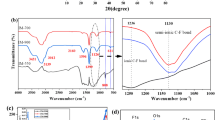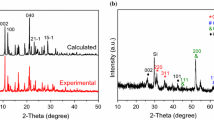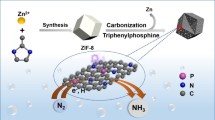Abstract
Heteroatom-doped carbon materials as alternative catalysts for oxygen reduction reaction (ORR) have drawn increasing attention due to their tunable chemical and electronic structures for achieving high activity and stability. However, there still remains a great challenge to fabricate porous heteroatoms dual-doped carbons with uniformly doping in a facile and controllable way. Herein, imidazole/imidazolium-functionalized metal-organic frameworks (MOFs) are employed as precursors and templates to achieve porous nitrogen and halogen dual-doped nanocarbons. Among these carbon materials, the as-prepared nitrogen/bromine dual-doped catalyst BrNC-800 exhibits the best ORR performance with a positive half-wave potential at 0.80 V (vs. RHE) in 0.1 mol L−1 KOH, which is comparable to the benchmark commercial 20 wt% Pt/C catalyst. BrNC-800 shows excellent long term stability and methanol tolerance. This work provides a facile approach to fabricate highly efficient heteroatoms dual-doped carbon catalysts for energy conversion.
摘要
低成本、高效稳定的非金属材料作为氧还原反应(ORR)的电催化剂对于燃料电池的规模化应用至关重要. 杂原子掺杂的多孔碳材料具有可调的化学组成和电子结构, 能显著提升氧还原催化活性. 基于此, 我们采用咪唑鎓盐功能化的金属-有机框架(MOFs)作为前驱体 和自牺牲模板, 制备了氮和卤素双掺杂多孔纳米碳催化剂. 其中氮/溴双掺杂催化剂BrNC-800在碱性条件下具有优异的电催化性能、稳定 性和抗甲醇毒化能力. 其优异的电催化活性归因于: (1) 大量吡啶氮和石墨氮的掺杂产生丰富的碳活性位点, 同时高的石墨化程度有助于 提高导电性, 促进氧还原活性; (2) 溴的存在改变了催化剂的化学组分和结构特征, 并活化相邻碳产生额外活性位点; (3) 高比表面和多级 孔结构有助于传质与增加暴露的氧还原活性位的数量, 而提高催化效率. 这项工作为以MOFs为前驱体制备高效的杂原子双掺杂碳材料提供了一种简便的方法.
Similar content being viewed by others
References
Steele BCH, Heinzel A. Materials for fuel-cell technologies. Nature, 2001, 414: 345–352
Dai L, Xue Y, Qu L, et al. Metal-free catalysts for oxygen reduction reaction. Chem Rev, 2015, 115: 4823–4892
Stamenkovic VR, Fowler B, Mun BS, et al. Improved oxygen reduction activity on Pt3Ni (111) via increased surface site availability. Science, 2007, 315: 493–497
Borup R, Meyers J, Pivovar B, et al. Scientific aspects of polymer electrolyte fuel cell durability and degradation. Chem Rev, 2007, 107: 3904–3951
Zhang J, Sasaki K, Sutter E, et al. Stabilization of platinum oxygenreduction electrocatalysts using gold clusters. Science, 2007, 315: 220–222
Zhang C, Sandorf W, Peng Z. Octahedral Pt2CuNi uniform alloy nanoparticle catalyst with high activity and promising stability for oxygen reduction reaction. ACS Catal, 2015, 5: 2296–2300
Huang X, Zhao Z, Cao L, et al. High-performance transition metaldoped Pt3Ni octahedra for oxygen reduction reaction. Science, 2015, 348: 1230–1234
Kuroki H, Tamaki T, Matsumoto M, et al. Refined structural analysis of connected platinum–iron nanoparticle catalysts with enhanced oxygen reduction activity. ACS Appl Energy Mater, 2018, 1: 324–330
Wu G, More KL, Johnston CM, et al. High-performance electrocatalysts for oxygen reduction derived from polyaniline, iron, and cobalt. Science, 2011, 332: 443–447
Byon HR, Suntivich J, Shao-Horn Y. Graphene-based non-noblemetal catalysts for oxygen reduction reaction in acid. Chem Mater, 2011, 23: 3421–3428
Lefèvre M, Proietti E, Jaouen F, et al. Iron-based catalysts with improved oxygen reduction activity in polymer electrolyte fuel cells. Science, 2009, 324: 71–74
Wang DW, Su D. Heterogeneous nanocarbon materials for oxygen reduction reaction. Energy Environ Sci, 2014, 7: 576–591
Liang Y, Li Y, Wang H, et al. Co3O4 nanocrystals on graphene as a synergistic catalyst for oxygen reduction reaction. Nat Mater, 2011, 10: 780–786
Zhang H, Zhou W, Chen T, et al. A modular strategy for decorating isolated cobalt atoms into multichannel carbon matrix for electrocatalytic oxygen reduction. Energy Environ Sci, 2018, 11: 1980–1984
Zeng L, Cui X, Shi J. A facile strategy for ultrasmall Pt NPs being partially-embedded in N-doped carbon nanosheet structure for efficient electrocatalysis. Sci China Mater, 2018, 61: 1557–1566
Tan H, Li Y, Jiang X, et al. Perfectly ordered mesoporous ironnitrogen doped carbon as highly efficient catalyst for oxygen reduction reaction in both alkaline and acidic electrolytes. Nano Energy, 2017, 36: 286–294
Wu S, Zhu Y, Huo Y, et al. Bimetallic organic frameworks derived CuNi/carbon nanocomposites as efficient electrocatalysts for oxygen reduction reaction. Sci China Mater, 2017, 60: 654–663
Bu L, Zhang N, Guo S, et al. Biaxially strained PtPb/Pt core/shell nanoplate boosts oxygen reduction catalysis. Science, 2016, 354: 1410–1414
Bu L, Shao Q, E B, et al. PtPb/PtNi intermetallic core/atomic layer shell octahedra for efficient oxygen reduction electrocatalysis. J Am Chem Soc, 2017, 139: 9576–9582
Bu L, Tang C, Shao Q, et al. Three-dimensional Pd3Pb nanosheet assemblies: high-performance non-Pt electrocatalysts for bifunctional fuel cell reactions. ACS Catal, 2018, 8: 4569–4575
Gong K, Du F, Xia Z, et al. Nitrogen-doped carbon nanotube arrays with high electrocatalytic activity for oxygen reduction. Science, 2009, 323: 760–764
Liu R, Wu D, Feng X, et al. Nitrogen-doped ordered mesoporous graphitic arrays with high electrocatalytic activity for oxygen reduction. Angew Chem, 2010, 122: 2619–2623
Sheng ZH, Shao L, Chen JJ, et al. Catalyst-free synthesis of nitrogen-doped graphene via thermal annealing graphite oxide with melamine and its excellent electrocatalysis. ACS Nano, 2011, 5: 4350–4358
Yang L, Jiang S, Zhao Y, et al. Boron-doped carbon nanotubes as metal-free electrocatalysts for the oxygen reduction reaction. Angew Chem, 2011, 123: 7270–7273
Sheng ZH, Gao HL, Bao WJ, et al. Synthesis of boron doped graphene for oxygen reduction reaction in fuel cells. J Mater Chem, 2012, 22: 390–395
Liu ZW, Peng F, Wang HJ, et al. Phosphorus-doped graphite layers with high electrocatalytic activity for the O2 reduction in an alkaline medium. Angew Chem, 2011, 123: 3315–3319
Yang Z, Yao Z, Li G, et al. Sulfur-doped graphene as an efficient metal-free cathode catalyst for oxygen reduction. ACS Nano, 2012, 6: 205–211
Yao Z, Nie H, Yang Z, et al. Catalyst-free synthesis of iodine-doped graphene via a facile thermal annealing process and its use for electrocatalytic oxygen reduction in an alkaline medium. Chem Commun, 2012, 48: 1027–1029
Jeon IY, Choi HJ, Choi M, et al. Facile, scalable synthesis of edgehalogenated graphene nanoplatelets as efficient metal-free eletrocatalysts for oxygen reduction reaction. Sci Rep, 2013, 3: 1810
Zhang M, Dai L. Carbon nanomaterials as metal-free catalysts in next generation fuel cells. Nano Energy, 2012, 1: 514–517
You C, Jiang X, Wang X, et al. Nitrogen, sulfur co-doped carbon derived from naphthalene-based covalent organic framework as an efficient catalyst for oxygen reduction. ACS Appl Energy Mater, 2018, 1: 161–166
Liang J, Jiao Y, Jaroniec M, et al. Sulfur and nitrogen dual-doped mesoporous graphene electrocatalyst for oxygen reduction with synergistically enhanced performance. Angew Chem Int Ed, 2012, 51: 11496–11500
Guo Z, Jiang C, Teng C, et al. Sulfur, trace nitrogen and iron codoped hierarchically porous carbon foams as synergistic catalysts for oxygen reduction reaction. ACS Appl Mater Interfaces, 2014, 6: 21454–21460
Li J, Chen Y, Tang Y, et al. Metal–organic framework templated nitrogen and sulfur co-doped porous carbons as highly efficient metal-free electrocatalysts for oxygen reduction reactions. J Mater Chem A, 2014, 2: 6316–6319
Yan D, Guo L, Xie C, et al. N, P-dual doped carbon with trace Co and rich edge sites as highly efficient electrocatalyst for oxygen reduction reaction. Sci China Mater, 2018, 61: 679–685
Jiang S, Sun Y, Dai H, et al. Nitrogen and fluorine dual-doped mesoporous graphene: a high-performance metal-free ORR electrocatalyst with a super-low HO2 -yield. Nanoscale, 2015, 7: 10584–10589
Peera SG, Sahu AK, Arunchander A, et al. Nitrogen and fluorine co-doped graphite nanofibers as high durable oxygen reduction catalyst in acidic media for polymer electrolyte fuel cells. Carbon, 2015, 93: 130–142
Paraknowitsch JP, Thomas A. Doping carbons beyond nitrogen: an overview of advanced heteroatom doped carbons with boron, sulphur and phosphorus for energy applications. Energy Environ Sci, 2013, 6: 2839–2855
Yang Z, Nie H, Chen X, et al. Recent progress in doped carbon nanomaterials as effective cathode catalysts for fuel cell oxygen reduction reaction. J Power Sources, 2013, 236: 238–249
Ranjbar Sahraie N, Paraknowitsch JP, Göbel C, et al. Noble-metalfree electrocatalysts with enhanced ORR performance by taskspecific functionalization of carbon using ionic liquid precursor systems. J Am Chem Soc, 2014, 136: 14486–14497
Fellinger TP, Su DS, Engenhorst M, et al. Thermolytic synthesis of graphitic boron carbon nitride from an ionic liquid precursor: mechanism, structure analysis and electronic properties. J Mater Chem, 2012, 22: 23996–24005
Fulvio PF, Lee JS, Mayes RT, et al. Boron and nitrogen-rich carbons from ionic liquid precursors with tailorable surface properties. Phys Chem Chem Phys, 2011, 13: 13486–13491
Lee JS, Wang X, Luo H, et al. Facile ionothermal synthesis of microporous and mesoporous carbons from task specific ionic liquids. J Am Chem Soc, 2009, 131: 4596–4597
Mahmood A, Guo W, Tabassum H, et al. Metal-organic framework-based nanomaterials for electrocatalysis. Adv Energy Mater, 2016, 6: 1600423
Dang S, Zhu QL, Xu Q. Nanomaterials derived from metal–organic frameworks. Nat Rev Mater, 2017, 3: 17075
Liu B, Shioyama H, Akita T, et al. Metal-organic framework as a template for porous carbon synthesis. J Am Chem Soc, 2008, 130: 5390–5391
Jiang HL, Liu B, Lan YQ, et al. From metal–organic framework to nanoporous carbon: toward a very high surface area and hydrogen uptake. J Am Chem Soc, 2011, 133: 11854–11857
Aijaz A, Akita T, Yang H, et al. From ionic-liquid@metal–organic framework composites to heteroatom-decorated large-surface area carbons: superior CO2 and H2 uptake. Chem Commun, 2014, 50: 6498–6501
Jiang HL, Xu Q. Porous metal–organic frameworks as platforms for functional applications. Chem Commun, 2011, 47: 3351–3370
Hu M, Reboul J, Furukawa S, et al. Direct carbonization of Albased porous coordination polymer for synthesis of nanoporous carbon. J Am Chem Soc, 2012, 134: 2864–2867
Yi FY, Zhang R, Wang H, et al. Metal-organic frameworks and their composites: synthesis and electrochemical applications. Small Methods, 2017, 1: 1700187
Lin T, Chen IW, Liu F, et al. Nitrogen-doped mesoporous carbon of extraordinary capacitance for electrochemical energy storage. Science, 2015, 350: 1508–1513
Meng J, Niu C, Xu L, et al. General oriented formation of carbon nanotubes from metal–organic frameworks. J Am Chem Soc, 2017, 139: 8212–8221
Zhao S, Yin H, Du L, et al. Carbonized nanoscale metal–organic frameworks as high performance electrocatalyst for oxygen reduction reaction. ACS Nano, 2014, 8: 12660–12668
Tang H, Yin H, Wang J, et al. Molecular architecture of cobalt porphyrin multilayers on reduced graphene oxide sheets for highperformance oxygen reduction reaction. Angew Chem, 2013, 125: 5695–5699
Xia W, Zou R, An L, et al. A metal–organic framework route to in situ encapsulation of Co@Co3O4@C core@bishell nanoparticles into a highly ordered porous carbon matrix for oxygen reduction. Energy Environ Sci, 2015, 8: 568–576
Lu XF, Gu LF, Wang JW, et al. Bimetal-organic framework derived CoFe2O4/C porous hybrid nanorod arrays as high-performance electrocatalysts for oxygen evolution reaction. Adv Mater, 2017, 29: 1604437
Liang J, Chen RP, Wang XY, et al. Postsynthetic ionization of an imidazole-containing metal–organic framework for the cycloaddition of carbon dioxide and epoxides. Chem Sci, 2017, 8: 1570–1575
Pachfule P, Biswal BP, Banerjee R. Control of porosity by using isoreticular zeolitic imidazolate frameworks (IRZIFs) as a template for porous carbon synthesis. Chem Eur J, 2012, 18: 11399–11408
Zhao X, Zou X, Yan X, et al. Defect-driven oxygen reduction reaction (ORR) of carbon without any element doping. Inorg Chem Front, 2016, 3: 417–421
Zhu Y, Murali S, Cai W, et al. Graphene and graphene oxide: synthesis, properties, and applications. Adv Mater, 2010, 22: 3906–3924
Zhang L, Wang X, Wang R, et al. Structural evolution from metal–organic framework to hybrids of nitrogen-doped porous carbon and carbon nanotubes for enhanced oxygen reduction activity. Chem Mater, 2015, 27: 7610–7618
Zheng J, Ekström TC, Gordeev SK, et al. Carbon with an onionlike structure obtained by chlorinating titanium carbide. J Mater Chem, 2000, 10: 1039–1041
Kundu S, Nagaiah TC, Xia W, et al. Electrocatalytic activity and stability of nitrogen-containing carbon nanotubes in the oxygen reduction reaction. J Phys Chem C, 2009, 113: 14302–14310
Guo D, Shibuya R, Akiba C, et al. Active sites of nitrogen-doped carbon materials for oxygen reduction reaction clarified using model catalysts. Science, 2016, 351: 361–365
Guan BY, Yu L, (David) Lou XW. A dual-metal–organicframework derived electrocatalyst for oxygen reduction. Energy Environ Sci, 2016, 9: 3092–3096
Vikkisk M, Kruusenberg I, Joost U, et al. Electrocatalytic oxygen reduction on nitrogen-doped graphene in alkaline media. Appl Catal B-Environ, 2014, 147: 369–376
Zhang G, Luo H, Li H, et al. ZnO-promoted dechlorination for hierarchically nanoporous carbon as superior oxygen reduction electrocatalyst. Nano Energy, 2016, 26: 241–247
Chang H, Joo SH, Pak C. Synthesis and characterization of mesoporous carbon for fuel cell applications. J Mater Chem, 2007, 17: 3078–3088
Liang J, Du X, Gibson C, et al. N-doped graphene natively grown on hierarchical ordered porous carbon for enhanced oxygen reduction. Adv Mater, 2013, 25: 6226–6231
Shi PC, Yi JD, Liu TT, et al. Hierarchically porous nitrogen-doped carbon nanotubes derived from core–shell ZnO@zeolitic imidazolate framework nanorods for highly efficient oxygen reduction reactions. J Mater Chem A, 2017, 5: 12322–12329
Zhang L, Su Z, Jiang F, et al. Highly graphitized nitrogen-doped porous carbon nanopolyhedra derived from ZIF-8 nanocrystals as efficient electrocatalysts for oxygen reduction reactions. Nanoscale, 2014, 6: 6590–6602
Lai L, Potts JR, Zhan D, et al. Exploration of the active center structure of nitrogen-doped graphene-based catalysts for oxygen reduction reaction. Energy Environ Sci, 2012, 5: 7936–7942
Bao Z, Chang G, Xing H, et al. Potential of microporous metal–organic frameworks for separation of hydrocarbon mixtures. Energy Environ Sci, 2016, 9: 3612–3641
Zheng F, Yang Y, Chen Q. High lithium anodic performance of highly nitrogen-doped porous carbon prepared from a metalorganic framework. Nat Commun, 2014, 5: 5261
Acknowledgements
We acknowledge the financial support from the National Key Research and Development Program of China (2018YFA0208600), National Basic Research Program of China (973 Program, 2014CB845605), Key Research Program of Frontier Science, Chinese Academy of Sciences (QYZDJ-SSW-SLH045), Strategic Priority Research Program of the Chinese Academy of Sciences (XDB20000000), National Natural Science Foundation of China (21671188, 21871263, 21521061 and 21331006) and Youth Innovation Promotion Association, Chinese Academy of Sciences (2014265).
Author information
Authors and Affiliations
Corresponding authors
Additional information
Qiao Wu received her bachelor’s degree from the School of Chemistry and Chemical Engineering, Henan Normal University in 2016. She is currently a master candidate in the College of Chemistry and Materials Science, Fujian Normal University, Fuzhou, China. Her current research interests focus on designing high-performance electrode materials for energy storage systems.
Yuan-Biao Huang obtained his PhD in 2009 under the supervision of Prof. GX Jin from Fudan University. In the same year, he joined Prof. Rong Cao’s group at Fujian Institute of Research on the Structure of Matter (FJIRSM), Chinese Academy of Sciences (CAS). In 2014, he joined Prof. Qiang Xu’s group at the National Institute of Advanced Industrial Science and Technology as a JSPS (Japan Society for the Promotion of Science) fellow. In 2015, he moved back to Prof. Cao’s research group at FJIRSM. His research interest focuses on porous MOF and COF based materials for catalysis.
Rong Cao was born in Fujian province, China. He obtained his PhD from FJIRSM, CAS, in 1993. Following post-doctoral experience in the Hong Kong Polytechnic University and JSPS Fellowship in Nagoya University, he became a professor at FJIRSM in 1998. Now, he is the director of FJIRSM. His main research interests include supramolecular chemistry, inorganic–organic hybrid materials and nanocatalysis.
Electronic supplementary material
40843_2018_9364_MOESM1_ESM.pdf
Porous nitrogen/halogen dual-doped nanocarbons derived from imidazolium functionalized cationic metal-organic frameworks for highly efficient oxygen reduction reaction
Rights and permissions
About this article
Cite this article
Wu, Q., Liang, J., Yi, JD. et al. Porous nitrogen/halogen dual-doped nanocarbons derived from imidazolium functionalized cationic metal-organic frameworks for highly efficient oxygen reduction reaction. Sci. China Mater. 62, 671–680 (2019). https://doi.org/10.1007/s40843-018-9364-5
Received:
Accepted:
Published:
Issue Date:
DOI: https://doi.org/10.1007/s40843-018-9364-5




